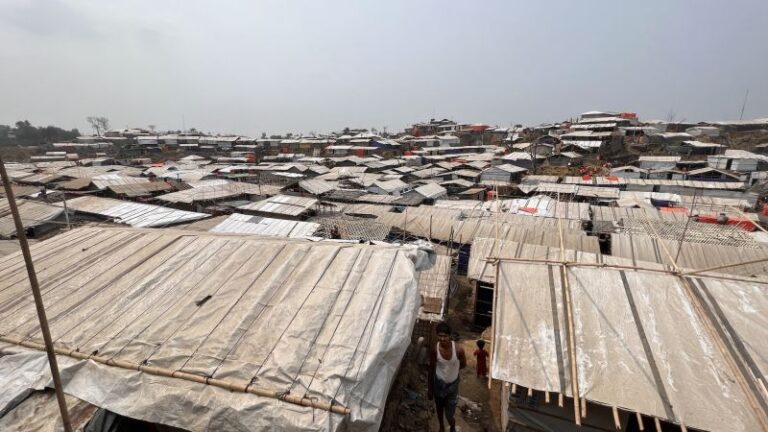(CNN) — A tropical storm is building up in the Bay of Bengal and is on course to hit the west Myanmar and Bangladesh’s Cox’s Bazar, where about 1 million people live in flimsy shelters in what many consider to be largest refugee camp in the world.
Cyclone Mocha is the first to form in the Bay this year and is expected to strengthen further before making landfall on Sunday, likely in western Myanmar’s Rakhine state, near the border with Bangladesh.
According to the Joint Typhoon Warning Center, Mocha strengthened Friday to the equivalent of a category 1 Atlantic hurricane and was moving northward at a speed of 11 kilometers per hour (7 miles per hour).
The storm’s winds could increase to 220 kph (137 mph) – equivalent to a category 4 Atlantic hurricane – before landfall on Sunday morning, the agency said.
cnnweather
Cyclone Mocha is strengthening in the Bay of Bengal.
India’s Meteorological Department said on Friday that Mocha had intensified into a very severe cyclonic storm and warned fishermen and trawlers against sailing far from the Bay in the coming days.
The agency predicted a storm surge of up to 2.5 meters (8.2 feet) would likely flood low-lying coastal areas in the storm’s path by the time of landfall.
In Bangladesh, that includes Cox’s Bazar, home to members of the stateless Rohingya community who fled persecution in neighboring Myanmar during a military crackdown in 2017. Many live in bamboo and tarpaulin shelters perched on hillsides vulnerable to strong winds, rain, and landslides.
02:30 – Source: CNN
Who are the Rohingya and why are they fleeing? (September 2017)
There are also concerns for the hundreds of Rohingya refugees who live in an isolated and flood-prone area island facility in the Bay of Bengal, called Bhasan Char.
Ahead of Mocha’s expected landfall, aid agencies are stepping up their emergency preparedness and response in local and refugee communities.
The UN refugee agency in Bangladesh said in a tweet that “emergency preparations in the camps and in Bhasan Char are underway” in coordination with the government and local aid agencies.
“In preparation for the storms, hundreds of Rohingya refugee volunteers have been trained in identifying hazards, informing their communities, evacuating people when necessary and responding after disaster strikes,” UNHCR said in a tweet.
02:56 – Source: CNN
Hundreds of Rohingya refugees relocated to island (December 2020)
In neighboring Myanmar, residents of coastal Rakhine state and Ayeyarwady region have begun evacuating their homes and seeking shelter ahead of the typhoon’s expected landfall, according in local independent media Myanmar Now.
The ruling Myanmar junta has issued storm warnings and said it is taking precautionary measures such as preparing disaster management committees to respond to a potential disaster, according to state media Global New Light of Myanmar.
The Joint Typhoon Warning Center said widespread flooding, landslides and strong winds are expected in the landfall area and throughout Myanmar’s interior.
The last named tropical cyclone to make landfall in Myanmar was Maarutha in April, 2017. Although Maarutha was equivalent to a tropical cyclone at landfall, with maximum winds of 92 kph (58 mph), it brought it rained heavily and damaged nearly 100 houses.
In October 2010, Tropical Cyclone Giri was the last storm to make landfall with hurricane-force winds. It made landfall as a high-end Category 4 equivalent hurricane with maximum winds of 250 kph (155 mph).
Giri caused more than 150 deaths and about 70% of the city of Kyaukphyu, in Rakhine state, was destroyed. According to the United Nations, about 15,000 homes were destroyed in the state during the storm.
The worst natural disaster to hit Myanmar was Cyclone Nargis in May 2008, killed 140,000 people, severely affected 2.4 million and left 800,000 homeless, aid agencies said.
